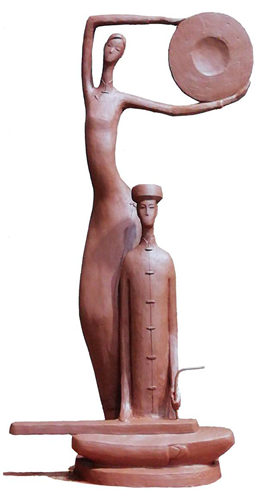 |
|
A work that depicts musicians of the Jing ethnic group by Huang Bingyi is on display. [Photo provided to China Daily] |
Wang, who was trained at the prestigious National High School of Fine Arts in Paris, was one of the pioneers of modern Chinese sculpture. His work depicts a jolly scene in which people from various ethnic backgrounds dance to music performed with different types of instrument.
Wu says Wang's oeuvre of work shows the mastery of a figurative approach he learned in France fused with the grace and mellow mood of Eastern aesthetics.
He says a similar ambition to establish a modern Chinese view on beauty and to serve ordinary people is shared by several artists, including Liu Kaiqu, who also studied in Paris and was the first director of the National Art Museum of China.
Liu sculpted several monumental works that hail national independence, including the design of the reliefs on the Monument to the People's Heroes, located in the Tian'anmen Square. His work on show, however, is a small white marble sculpture of a Tibetan yak. The smoothness and soft sheen of the yak reminds one of the presentation of hada, a pure white ceremonial scarf, or the snow-capped mountains and curling clouds in the Tibetan area.
Wu says Liu rendered the yak with the imposing manner of a monument, which shows his studies of Western sculpture, but he also imported a touch of Chinese poetry to reinforce its divine spirit.
When the art community began to explore an abstract, experimental style, Tian Shixin was an prominent figure. Born in Beijing, he created figurines that are reduced in detail and feature clear-cut lines to present the objects' spiritual energy.
He based his creations on the rich ethnic arts of Guizhou province in Southwest China, where he lived for about 25 years before moving back home in the 1980s.
Tian has for decades produced a series of wood statuettes of ethnic people he met in Guizhou, including the wood sculpture on show, Column of Joy, which portrays a young mother of the Dong ethnic group lifting her child above her head. He sculpted the work in the shape of a cylinder, reminiscent of a totem pole or a monument, by which he hails motherhood.
Tian says, "The years living in Guizhou were a time when I felt relaxed and daring, and ultimately devoted to nothing but pure art. I haven't felt the same while in Beijing."